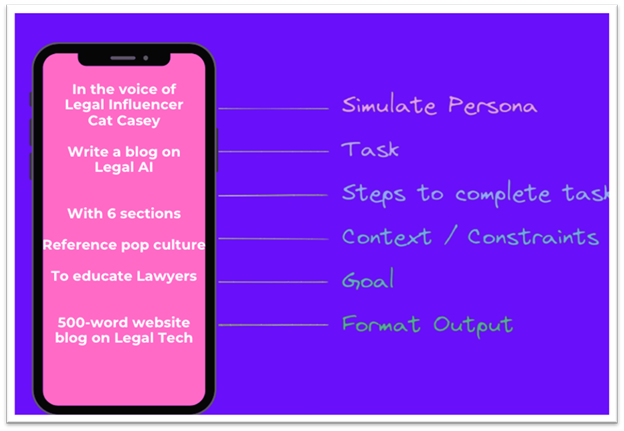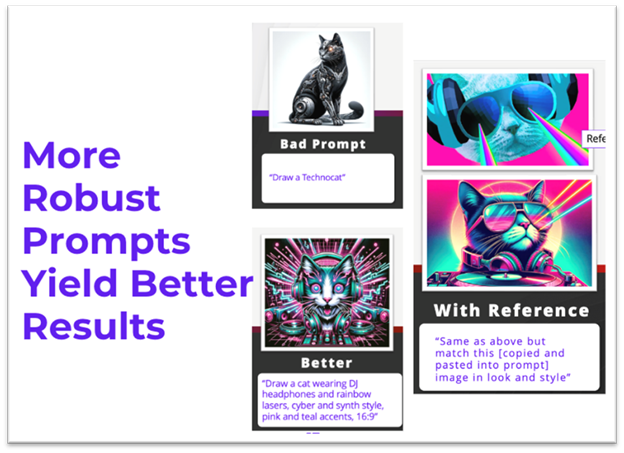Think of a prompt like a cheat code to get Generative Artificial Intelligence (GAI) to do what you want. Rather than going in bling, you are helping the Large Language Model (LLM) more accurately guess the output you want. And Prompt engineering is the discipline of mastering AI prompting!
It is a way to guide your AI Chatbot in the right direction. In ChatGPT, prompt engineering is crafting these nudges into practical directions for the AI to follow. Even beginners can achieve stellar AI-powered results with the right prompts.
You want the AI not just to understand your query but to read between the lines. By refining how you ask, you’re essentially programming this AI Helper to deliver responses rich in detail and relevance, tailored precisely to what you – the maestro of Legal Lingo – aim to showcase.
In a more traditional sense, prompt engineering is the strategic formulation of inputs to guide an AI model, like GAI, to generate specific and valuable outputs. For legal professionals, this means crafting prompts that convey the legal objectives, target demographics, and the desired tone. These enable the AI to produce content and visuals that hit the mark every time.

What Are the Key Ingredients for a Good Prompt?
Not all prompts are created equal, folks. Just like you wouldn’t ask a stranger for directions with “Go down a bit, pass a goat, turn right, and you’ll get there,” your prompts to ChatGPT need precision and clarity. Let’s break it down, TechnoCat style:
Task: What do you want ChatGPT to do?
ChatGPT is your digital Swiss Army knife. It can craft blog outlines, summarize legal documents, identify tones, create memo bullets, whip up deposition questions, and even design PowerPoint decks. But it needs a nudge in the right direction.
- Example: For an image prompt, you might say, “Draw a picture of a white cat holding a tablet that says ‘CatGPT’ and looks like the UX of ChatGPT.”
Context: What unique factors do you want to be reflected?
Details, details, details! The more context you provide, the better the AI can nail the task. Think word counts, blog sections, specific elements—get granular.
- Example: Adding brand-specific touches like, “Include pink and teal accents, with a white background.”
Persona/Style: Who is ChatGPT answering the questions as?
Give ChatGPT a personality! Want it cheeky? Serious? Academic? Be clear about the voice you want. No one wants a boring, robotic response.
- Example: For a visual style, you might say, “Make it Cyberpunk and Synthwave.” Think neon lights, techy vibes, and that cool 80s aesthetic.

Goal/Audience: Who is ChatGPT talking to, and what is the goal?
Tailor the output to your audience. Whether it’s legal tech lawyers, judges, law students, or an ELI5 explanation, specifying this helps refine tone and complexity.
- Example: Skip this if not relevant for the task, like image creation.
Format: What format is the output?
Define the structure. Is it an outline, a list, a table, a presentation, or an image? Be specific to get exactly what you need.
- Example: For an image, specify the aspect ratio, like “16:9.”
Bringing it all together
- Example Prompt: “Draw a picture of a white cat holding a tablet that says ‘CatGPT’ and looks like the UX of ChatGPT, with pink and teal accents, a white background, in a Cyberpunk and Synthwave style. 16:9 aspect ratio.”
By mixing these key ingredients into your prompts, you’ll whip up responses that are not just relevant but also spot-on to your needs. Happy prompting!

Prompts: The Good, the Bad, the Ugly
Not all prompts are the same; some are real stinkers. Imagine asking a stranger for directions; which of these is more helpful?
- “Go down a little bit that way, pass a goat, turn right, and drive a bit…”
- “Drive 0.5 miles on the main street, take a right on the first street, drive another quarter mile, and the destination is on your left.”
Similarly, certain factors make a prompt more useful and effective at directing generative AI. In the example above, the first response was subjective, lacked clarity, and relied on the whim of a goat to stay put to be effective. The second example was more concrete, used specific distances and directions to improve clarity, and was not goat-dependent!
Much like giving directions, there are some clear don’ts when it comes to prompting:
Don’t Be Vague
Avoid vague or subjective requests. Tell the AI exactly what you want it to do.
- Example to Avoid: “Tell me about law.”
- Better: “Explain the impact of the GDPR on international businesses.”
Don’t Be Overly Complex
Using unnecessarily complicated language can confuse the AI.
- Example to Avoid: “Expound upon the legal ramifications inherent in the GDPR’s cross-jurisdictional applications.”
- Better: “Describe the legal impact of the GDPR on businesses operating in multiple countries.”
Don’t Be Ambiguous
Avoid prompts that can be interpreted in multiple ways.
- Example to Avoid: “What’s the weather?”
- Better: “What’s the weather forecast for tomorrow in New York City?”
Don’t Neglect Context
Provide enough context so the AI knows what you’re referring to.
- Example to Avoid: “What happened in 1995?”
- Better: “What significant legal events occurred in the US in 1995?”
Don’t Ask Too Many Questions at Once
Bombarding the AI with multiple questions in one prompt can lead to incomplete answers.
- Example to Avoid: “What’s the weather and who won the game last night and tell me a joke?”
- Better: Separate these into individual prompts.
Don’t Have Unrealistic Expectations
Don’t expect the AI to perform tasks beyond its capabilities, like real-time fact-checking or personal advice.
- Example to Avoid: “Tell me the exact stock prices right now.”
- Better: “Explain how stock prices are generally influenced by market trends.”
By avoiding these pitfalls, you can craft more effective prompts that yield accurate and helpful responses from generative AI models.

Try, Try Again
Now that you understand the broad strokes of using natural language processing and large language models via effective prompting… go try it out! Whether you turn to Open AI’s ChatGPT, Claude, or Google Search Generative experience, try out prompting today.
The AI prompt process will not yield perfect results at first, but that is part of the magic of Generative AI. You fine-tune your prompts to improve outputs and iterate to train the GPT models to reach your desired output. Optimize your prompt at the outset to make the step-by-step process run more efficiently.
Prompting practice makes perfect! Check out my eBook on Prompt engineering for legal!


